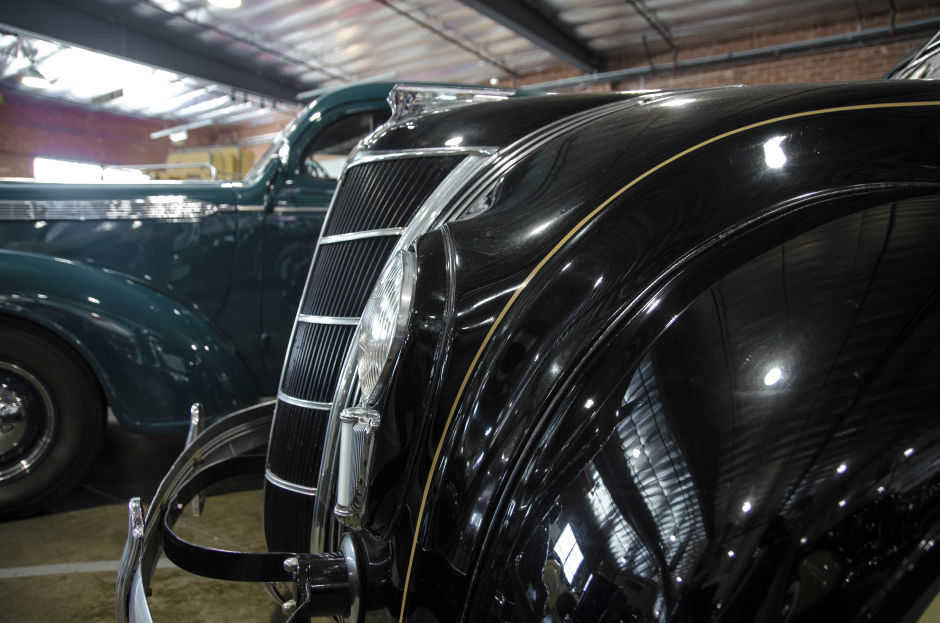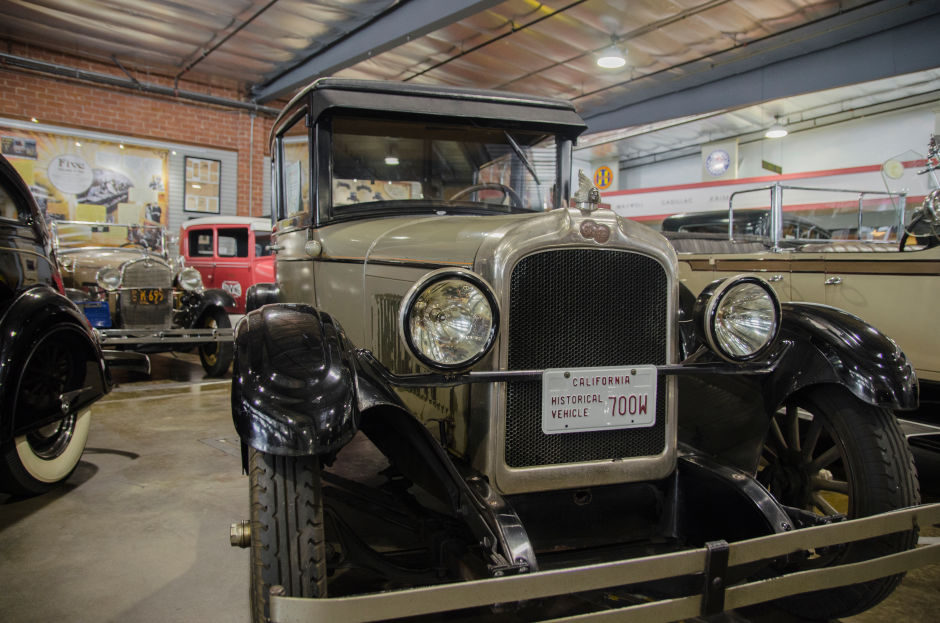Touch Don’t Look! A Tour of the Automobile Driving Museum in El Segundo, Ca
“Look, don’t touch”. A warning synonymous to every car show and museum around. “Look, don’t touch”, the father says to his child as he tucks whatever may be hanging from his neck into his shirt. “Look, don’t touch”, the sign on the wall demands. A dogma borne out of respect for the cars and their caretakers. Stand a few feet away. Put your hands behind your back and lean forward to get a closer view. We have all done it. It is just what you do. Or so I’ve thought.
Hidden away in an industrial area near Los Angeles International Airport, there is a museum that stands in defiance of the oppressive mantra. At the Automobile Driving museum in Los Angeles, visitors are encouraged to engage with the cars on display. There are no ropes around the cars. The windows are rolled down and the doors are unlocked inviting you in. On Sundays, the keys are in the ignition and selected cars are driving down the street. For a suggested donation of ten dollars, visitors are able to truly interact and absorb the essence of over 125 vehicles of various vintages .
Part One: A Sensational Iconoclastic View of the Car Show
Every car in the huge space is significant in some way. The museum strives to give its patrons an accurate depiction of the scope of automobiles at any given time in American history. The exhibit has a scheduled rotation of vehicles between the floor, the shop, and storage. Unlike the car show on Sunday morning, it is not only the “cool” cars that demand attention. Perfect examples of everyday commuters and quirky flops are at the forefront of your attention as well. A mid-sixties four door base model Ford Falcon is valued just as high as the overwhelmingly beautiful interior of the Ford Thunderbird alongside. The bespoke opulence of a ’36 Packard Dietrich convertible stands in stark contrast to an early ‘90’s Chrysler Town and Country minivan clad in factory faux wood trim. The cleanest ‘80’s Chevy Caprice California Highway Patrol car is parked menacingly behind a ’71 Dodge Challenger RT 440 six pack with drag slicks, roll cage, and parachute. This unbridled comparison allows for stark interpretations and a tactile means of learning not found in any other museum in Southern California.
Sitting in a car dramatically changes the outlook. The ability to infer a vehicle’s nature is drastically limited when unable to discover the resistance behind a chrome dash switch or feel the lacquered steering wheel. A sense of participation cannot be felt simply by looking at a car. To truly understand and sense what it would have been like to drive a vehicle one must sit in it. Only then, once you’ve realized the length of the hood in front of you, or appreciated the unrivaled visibility of bubbled 50’s front windows do you get a firm grasp on the reason for its existence in the museum.
This interactive tactile element to ADM is in thanks to its founder, Stanley Zimmerman. Beginning as a private collection in the 1970s, Stanley opened his doors to the public 17 years ago at a different location. ADM found its home in El Segundo in 2007 when they took over an old Howard Hughs assembly plant. The story goes, Mr. Zimmerman despised going to museums to look at cars he couldn’t get up close to see inside of. His personal collection was valued higher than a majority of cars on display yet he drove his constantly and the museum cars sat as a prison to time only touched by a blessed few. With this in mind, he made the decision to grant public access to not only his collection but to the vehicle’s hearts.
Part Two: An Inside Look. Spectacular Cars Tied to History
Almost every car in the Automobile Driving Museum has a unique story which provides its value to the narrative presented. I was fortunate to have my friend, Alec Harrell-Carlson to orate the rich history I had before me. Alec is the Collection Manager for ADM. He is as much an exhibit in the museum as the cars he oversees. At 23 years old, Alec has achieved a great deal rather quickly but make no mistake, he earned it. Discovering ADM in a newspaper at the age of 11, he decided to go every weekend and asked to become a volunteer. Over the course of a defining decade, he has become one of the most knowledgable individuals when it comes to classic American automobiles. As collection manager Alec has a hand in everything from procurement, to maintenance, to the arrangement on the show floor. He is a one stop shop for ADM.
I asked Alec to show me some of the most interesting vehicles on display. I was first led over to a 1935 Chrysler Airflow. The Airflow was both the first automobile designed in a wind tunnel and the first American car to utilize a unibody construction. The design featured a rounded body, integrated headlights, and a 50–50 weight distribution with passengers. It was extremely advanced for its time. Cars at the time were still utilizing a “two-box” design philosophy with wood being used for structural frame members. The Airflow despite its advanced design was a market failure. The design was too radical to the average buyer. Very few models were sold and afterwards Chrysler returned to more traditional and less advanced vehicles.
Parked next to the Airflow was a humble muted grey Pontiac from 1926. As we were walking by it to head to the Grand Salon where a vintage Packard had caught my eye, Alec casually mentions the Pontiac is the oldest left in existence. Inside, the odometer reads 15,875. I failed to ask how many of those miles were put onto the vehicle after ADM had possession.
Along the front wall to the right of the entrance of the museum floor resides the Grand Salon. While all the cars on the floor are accessible without any sort of docent guide or supervision, the Salon requires it for good reason. The six cars on display look out the glass partition like Gatsby looked down upon the party dwellers. While none of them were subdued in the least bit possible two cars demand more attention than the rest. A gleaming off white ’36 Packard Dietrich convertible and a ’30 Stutz Monte Carlo sit center stage. The Packard and the Stutz play off each other like a white hatted cowboy staring down his nefarious counterpart. The Packard with its smooth and long curves and soft appearance is jarred by the aggressive cool factor of the Stutz. Possessing a dramatically low roof line and hard edges, the Stutz gives off the sensation of a hot rod despite its luxurious interior.
Part Three: a One Stop Shop; Behind the Scenes
The willingness to allow the public to engage with this priceless collection is paramount to what makes it a must see location. Unlike art installations where a sculpture or painting is devalued with the slightest of damage be it a chip or a scrape, a car is repairable. At ADM, they embrace this. As one of the docents described, “when people get in the cars the damage they do is maybe, 20, 30 or 40 dollars…If they break a nob off or something like that, we can fix that”.
Every car in the collection is in running quality and driven for the public. To accomplish this feat, the Automobile Driving Museum has a fully equipped maintenance shop in the back. Unlike the Peterson with its salaried repair staff, the ADM is a volunteer heavy organization. Ambitious and passionate individuals like Alec Harrell-Carlson who started as a volunteer so long ago breath life into these machines with their sweat and blood. Everything from general maintenance to complete engine rebuilds and chassis restoration is accomplished in house.
As Alec put it, “the only things we don’t do are chrome and paint”. This level of involvement with the vehicles on display plays a big part in why the docents are so knowledgable and loving of their vehicles. When visiting another museum you can tell the majority of the tour guides are reciting a script. When asked an unexpected question there is a significant probability the answer provided may be incorrect. The extra level of information available from ADM’s docents is bred from the work put in behind the scenes as well as physically driving the vehicles themselves.
The shop is filled with intriguing pieces of automotive memorabilia. By the back door is a General Motors inline 6 converted into a cutaway for the United States Navy for educating sailors on the internal combustion engine. Along the wall there is a miniature race car that used to be an original attraction at the Pacific Park on the Santa Monica Pier. The walls are adorned with distinct signage and banners from the past. The shop is both clean and cluttered. The workspaces and bays are pristine, the desks and walls show the character of those who wrench within. The ADM garage is a place of work but you can tell those who use it consider it play.
Their work provides a unique experience that is a must see for every automotive enthusiast in Southern California and something other collections should do their best to emulate. I would like to thank the Automotive Driving Museum and the docents who volunteer their time for the benefit of the public. I would also like to thank Alec Harrell-Carlson for taking the time to show me around and educating me and many others.
If you would like to know more, you can visit their website at https://www.automobiledrivingmuseum.org
The museum is located at:
610 LAIRPORT ST
EL SEGUNDO, CA 90245
310.909.0950
Hours:
Main Building
10:00 a.m.–4:00 p.m.
Rides–Sundays Only
10:00 a.m.–3:30 p.m.
Part Four: The Gallery

























